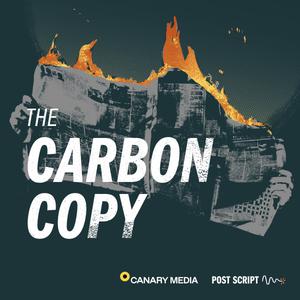
The Interchange
Wood Mackenzie
The Interchange: Recharged podcast is a leading global clean tech podcast that has been running since 2017. Each fortnight we invite experts and industry leaders from the world of clean tech and energy to join in a deep dive about their tech, the future of their sector, funding and policy impacts. We aim to provide a platform for start-ups, new companies and organisations who are innovating and solving real world problems in the energy transition. Our listeners are energy experts, industry evangelists who’re interested in companies that do pioneering work to accelerate the transition. Our host David Banmiller takes our audience through a 45-60 minute exploration of the revolutionary tech these companies are developing, asking about the history, the ongoing work and the vision our guests have for their business. The conversation often turns to funding and policy as well.
- 38 minutes 51 secondsWhat’s the energy transition going to cost?
Estimates for the cost of decarbonising could be inaccurate. What does that mean for investment and policy-making?
About $1.2 trillion is invested annually in climate technology and infrastructure worldwide, with significant portions allocated to China due to its accelerated decarbonization goals. However, experts argue that about $9 trillion could be needed annually to effectively counter climate change, indicating a substantial gap in current funding. Debate continues over the economic feasibility of such costs, to the detriment of progress, but what if the cost was actually far less? RMI, the research and clean energy advocacy group, says that this may indeed be the case. These forecasts could be overinflated by trillions of dollars. If that’s true, what will it mean for investors, markets and policy?
Host David Banmiller is joined by Dan Goldman, managing partner at Clean Energy Ventures, a VC that funds startups developing early stage breakthrough technologies. He says the there’s a significant investment shortfall – regardless of the total cost of decarbonising – currently to stabilise global temperatures. He discusses a downturn in venture capital investments in climate tech, particularly affecting early-stage companies and innovation in new technologies. Challenges remain in scaling up clean energy technologies due to a combination of high interest rates, inflationary pressures, and supply chain disruptions, which increase costs and complicate project implementations.
There's a specific shortfall in investment for infrastructure necessary for large-scale renewable energy implementations, like wind and solar, which are essential for a robust energy transition. David and Dan discuss how this could be addressed, and analyse the current economic environment, characterized by high costs and uncertain returns.
Is it these barriers that are hindering significant capital flow into this sector, or the forecasted cost for decarbonising global energy systems? How can global financial strategies be adjusted to accelerate the necessary investments in clean energy and technology? Find out on the show.
See Privacy Policy at https://art19.com/privacy and California Privacy Notice at https://art19.com/privacy#do-not-sell-my-info.
23 April 2024, 11:00 am - 34 minutes 10 secondsCan we rely on nuclear as a source of clean, reliable power?
SMRs: a new horizon in Nuclear Power.
This week on The Interchange: Recharged, David is joined by Ted Nordhaus, Executive Director at the Breakthrough Institute, an environmental research centre in Berkley, California. They focus on finding technological solutions to environmental problems.
Achieving a net-zero emission grid by 2050, they claim, with a significant nuclear component would not only be feasible but also cost-effective compared to over-reliance on variable renewable energy sources. This approach requires substantial investment, estimated between US$150 to US$220 billion by 2035, escalating to over a trillion dollars by 2050. Together Ted and David discuss the likelihood that the private sector will drive this investment, provided that nuclear technologies are economically viable and regulatory uncertainties are addressed. They look at the Build Nuclear Now campaign, which aims to rally public support for nuclear energy and drive towards grassroots pro-nuclear advocacy. Is this a sign that public sentiment is changing?
The main challenges hindering the adoption of nuclear energy include regulatory hurdles, financial barriers and ongoing concerns surrounding nuclear safety. Ted explains that regulatory reform and public sector commitment could overcome these obstacles. The Nuclear Energy Innovation and Modernization Act are examples of a policy aimed at modernising the regulatory environment, to facilitate the licensing of advanced nuclear reactors.
So, are SMRs the solution to everything nuclear? They’re designed to produce between 50 to 300 MW of electricity per module, which is about one-third of the generation capacity of traditional nuclear power reactors. NuScale's design (listen back to our episode from April last year for more on this) for instance, is for a 77 MW module, with plans to deploy modules in groups that can generate up to 924 MW. The U.S. Department of Energy (DOE) has been actively supporting SMR development, investing over US$600 million in the past decade to assist in the design, licensing and siting of new SMR technologies in the U.S. The technology seems to be there, as does the baseline investment.
What’s next for the nuclear industry? Listen to find out.
See Privacy Policy at https://art19.com/privacy and California Privacy Notice at https://art19.com/privacy#do-not-sell-my-info.
9 April 2024, 10:00 am - 29 minutes 43 seconds$802 billion on the horizon: the current state of the EV market
New battery technology could get EV prices down and drive mass adoption
In this week’s episode of Wood Mackenzie’s The Interchange Recharged, host David Banmiller looks at the rapidly evolving landscape of EVs and the battery technology that powers them. Market sentiment in the US is up and down; despite a 40% sales increase from the last quarter of 2022 to the same period in 2023, the industry is struggling with competition from China amid a price war. Batteries have a critical role to play in accelerating mass EV adoption and so their dramatic cost reduction - nearly 90% over the past 14 years – has potentially sparked an EV revolution.
Joining David is Haresh Kamath, an expert in energy storage and clean tech from the Electric Power Research Institute (EPRI). Together, they explore the nuances of battery economics, the potential of cutting-edge technologies like solid-state batteries and the imperative of developing efficient recycling methods to sustain this green momentum.
They examine the challenges of scaling EV infrastructure and supply chains, looking forward at the technologies that will continue to drive down costs and extend EV ranges.
Subscribe to The Interchange Recharged on your preferred podcast platform, and join the conversation on X – we’re @interchangeshow.
See Privacy Policy at https://art19.com/privacy and California Privacy Notice at https://art19.com/privacy#do-not-sell-my-info.
26 March 2024, 12:00 pm - 36 minutes 46 secondsA ground-breaking new method of sustainable aviation fuel production
A breakthrough way of producing hydrocarbons, crucial to the aviation industry, could reduce costs and accelerate decarbonisation.
Sustainable aviation fuel (SAF) is a key component in the aviation industry's path to decarbonization, which contributes to only 2% of global carbon emissions but is actively seeking cleaner solutions. Airbus and other aerospace companies are leading the charge, with Airbus integrating over 11 million litres of SAF in its operations in 2023, reducing carbon emissions significantly. The industry aims to increase SAF production to 17.5 billion litres by 2030, supported by initiatives like the IRA.
On this episode of Wood Mackenzie's The Interchange Recharged, David Banmiller speaks with Andrew Symes, founder and CEO of OXCCU. They’re developing a more efficient way of converting CO2 and hydrogen into hydrocarbons, potentially a monumental step towards more scalable and environmentally-friendly fuels.
Despite technological advancements, challenges in financing, regulatory support, and talent acquisition persist. SAF's integration with existing aviation infrastructure without the need for modifications is one key benefit; it could create a smoother transition to greener aviation, with expectations for SAF to achieve cost parity with Jet A fuel (the current standard) as technology and scale improve. The SAF industry enjoys broad support from airlines, governments, and regulatory initiatives, who are pushing for increased SAF adoption towards a net-zero future by 2050. The technology behind SAF, and as Andrew explains, the science behind OXCCU, not only promises to revolutionize aviation but also has applications in producing chemicals and plastics, signalling a broader impact on sustainability across various sectors and the goal of a circular economy.
See Privacy Policy at https://art19.com/privacy and California Privacy Notice at https://art19.com/privacy#do-not-sell-my-info.
12 March 2024, 7:00 am - 33 minutes 58 secondsHow to create the skilled workforce of 2030
Half of the energy workforce is employed in clean energy technologies. By 2030, over 10 million new jobs will need to be filled as the energy transition continues. China, for example, employs 3 million workers in clean energy manufacturing – accounting for 80% of solar PV and EV battery manufacturing jobs globally. Skill shortages are as significant a bottleneck as lack of investment or supply chain constraints, so how can the industry ensure there’s enough people to build, maintain and design clean energy infrastructure?
On the show today, David Banmiller is joined by Caleigh Andrews, Energy Analyst and Modeller at the International Energy Agency. The IEA emphasises the need for clear policies that drive demand for clean technologies, in order to attract and retain skilled labor. Reskilling and attracting new people to the energy workforce require a combination of market incentives and political will, so what are these incentives? And what can governments do to incentivise reskilling?
AI can play a role in easing the skilling burden and establishing standardised credentials, but with manufacturing and maintenance a large part of it, are the use cases for AI limited?
See Privacy Policy at https://art19.com/privacy and California Privacy Notice at https://art19.com/privacy#do-not-sell-my-info.
27 February 2024, 12:00 pm - 34 minutes 51 secondsCutting the red tape around geothermal energy
Recent legislation in the US promises to be a boon for geothermal energy production.
In January, the US House Energy and Commerce Committee passed a bipartisan bill that could have a big impact on the geothermal sector. Effectively putting geothermal on the same footing as oil and gas - by excluding geothermal development from strict NEPA rules – the bill could cut the red tape and boost production in the sector.
Geothermal has a lot of potential. The DOE estimates it could contribute almost 10% of US energy capacity by 2050. New geothermal technology, which uses horizontal drilling to drill multiple wells into geothermal reservoirs from a single location, is a promising start, but more innovation is needed to become cost competitive.
Joining David to discuss the legislation, and the technology that underpins the geothermal sector, are Dr Joseph Moore - Research Professor at the University of Utah and Managing Principal Investigator at Utah FORGE, a geothermal research facility managed by the Energy & Geoscience Institute at the University of Utah, and sponsored by the DOE – and Lauren Boyd, Director of the EERE’s Geothermal Technologies Office, which is sponsoring the Utah FORGE laboratory.
Together they examine the cost, operation and scope for geothermal energy in the US.
See Privacy Policy at https://art19.com/privacy and California Privacy Notice at https://art19.com/privacy#do-not-sell-my-info.
13 February 2024, 12:00 pm - 39 minutes 57 secondsTransforming EV battery development through the power of AI
The traditional process of battery development is slow, expensive, and capital-intensive. AI can help overcome the challenges of predicting battery performance, exploring the vast design space, and conducting time-consuming cycle life testing. David Banmiller is joined by Alán Aspuru-Guzik, a professor at the University of Toronto specializing in Chemistry and Computer Science, and Jason Koeller, the CTO and Co-founder of Chemix, to examine the role of machine learning in EV battery development.
Chemix is exploring new ways of developing batteries for electric vehicles (EVs) by utilizing AI, aiming to make it faster and more efficient compared to the traditional, slower, and costlier methods. AI not only speeds up the development process by predicting performance and exploring design options, but also – as Professor Aspuru-Guzik explains - leads to innovative battery compositions that improve performance. The machines can do calculations in timeframes inconceivable for a human.
There are wide-ranging applications for AI in areas beyond battery development, including grid optimization and materials design. Professor Aspuru-Guzik shares insights into the work of the Acceleration Consortium, which aims to be a leading hub for AI-driven scientific advancements in various sectors. Jason addresses some of the practical challenges in the EV industry, such as the need for adaptable battery solutions and the hurdles in introducing new manufacturing technologies. Technological advancement in battery technology and charging infrastructure are progressing together, enabling growth in the EV market.
See Privacy Policy at https://art19.com/privacy and California Privacy Notice at https://art19.com/privacy#do-not-sell-my-info.
30 January 2024, 12:00 pm - 37 minutes 57 secondsChecking in on the hydrogen sector
What’s the outlook for low-carbon hydrogen in 2024?
Green hydrogen energy, by now well-regarded as a critical component in the energy transition, is still faced with significant challenges. It’s anticipated to significantly contribute to energy needs, with projections suggesting it could supply up to 35% of the UK's energy by 2050, and there's a push in the US to dramatically reduce hydrogen production costs. The sector is experiencing rapid growth with many projects in development but reaching the Final Investment Decision (FID) stage is a key hurdle, especially in the current economic climate of high interest rates and inflation. The sector is trying to manage high initial costs and a tendency for investments to favour blue hydrogen, which is currently more cost-effective.
To discuss the hydrogen market, and the policy and financial decisions to be made to accelerate the rollout, David Banmiller is joined by Murray Douglas and Vicky Paley. Murray is responsible for Wood Mackenzie’s global hydrogen and ammonia research, while Vicky heads up project delivery at Protium Green Solutions.
Together they look at the updates in legislation, permits and overall government policy we’ve seen in the last 6 months and can expect this year. The US, for example, has set definitive treasury rules to give a bit more clarity to the industry.
See Privacy Policy at https://art19.com/privacy and California Privacy Notice at https://art19.com/privacy#do-not-sell-my-info.
17 January 2024, 12:00 pm - 30 minutes 14 secondsAI is transforming demand-side management
The impact of Artificial Intelligence in energy management.
We're at a crossroads in the world of energy. The landscape is shifting with the increasing role of renewables, growing demand and the need for resilience against extreme weather. How do we manage power effectively to keep the grid stable and efficient? Using AI to manage demand is one possibility. The role of artificial intelligence in energy management is an exciting development. It's set to transform how we predict, price, trade and use power, all while boosting efficiency and reliability.
Managing the grid is like solving a complex puzzle in real-time. The old grid, built for predictable loads, now grapples with erratic consumption and the fickleness of renewables like solar and wind. AI steps in here, using data and machine learning to improve efficiency and strengthen the grid. AI outperforms traditional models in forecasting. While these conventional models are valuable, they often miss the finer details which can lead to forecast errors. AI, on the other hand, adapts rapidly to real-time changes, enhancing the predictability of supply and demand at a detailed level.
For the first Interchange episode of the year, David Banmiller welcomes David Miller from Gridmatic to discuss the ever-evolving use of AI in grid management.
Together they explore how AI is transforming strategic forecasting, risk management and optimisation in energy infrastructure. What are the current challenges for the grid and how could AI help? What investment is required in infrastructure to optimise the grid? And what are the regulatory measures in place that are helping and hindering the rollout of smart grids?
Subscribe to the Interchange Recharged so you don’t miss an episode. Find us on X – we’re @interchangeshow.
See Privacy Policy at https://art19.com/privacy and California Privacy Notice at https://art19.com/privacy#do-not-sell-my-info.
3 January 2024, 12:00 pm - 44 minutes 56 secondsCarbon capture technology leads the charge for a sustainable future
Bridging the gap and overcoming barriers in CCS expansion
It's no secret that achieving net-zero emissions requires a significant reduction in the use of fossil fuels. As the world looks to alternative energy sources to combat climate change, carbon capture and storage (CCS) emerges as a key technology enabling industries to decarbonize. By capturing carbon dioxide (CO2) emissions at their source and storing them underground, CCS can significantly mitigate the environmental impact of industries that are otherwise hard to green, such as cement production and power generation.
The International Energy Agency (IEA) has set an ambitious goal for CCS, expecting it to capture around 6 billion tons of CO2 by 2051 with notable advancements within the coming years. Innovations in CCS technology aim to address concerns of scalability and cost, making it more accessible and financially feasible for industries to adopt.
Aker Carbon Capture is a provider with some major projects underway, and they’ve signed an MoU with Microsoft to pursue joint innovation in the space. David Banmiller sits down with Microsoft’s Ole Henrik Ree, and Aker Carbon Capture’s Hanne Rolen, and David Phillips, to discuss the crucial role played by CCS in achieving a more sustainable future.
We conclude with a discussion about the 'Carbon Capture as a Service' (CCaaS) model, a shift aimed at enhancing accessibility and practicality, and the journey towards achieving net-zero emissions.
Subscribe to the Interchange Recharged so you don’t miss an episode. Find us on X – we’re @interchangeshow
See Privacy Policy at https://art19.com/privacy and California Privacy Notice at https://art19.com/privacy#do-not-sell-my-info.
20 December 2023, 12:00 pm - 37 minutes 48 secondsTextile recycling is helping create a circular economy
Tackling the global textile waste challenge.
The fashion and textile industries are at a pivotal point, urgently needing to incorporate sustainable practices, particularly in textile recycling. With the industry's shift towards synthetic materials like polyester, there's a significant challenge in handling the large quantity of textile waste, estimated at 92 million tons globally every year. Emerging chemical textile recycling technologies, especially those focusing on common polyester-cotton blends, are key to reducing waste and decreasing reliance on new raw materials.
This has major implications for the circular economy; if you can reduce textile waste to zero then the techniques could theoretically be used across other manufacturing sectors. To discuss this, David Banmiller is joined by Toby Moss and Erik Koep from Worn Again. Worn-Again focuses on recycling polycotton blends, which make up 80% of all textiles.
Erik and Toby explain how they navigate the intricacies of recycling materials in a world where the average garment contains multiple fabric blends, often with less than 1% of unknown materials. What strategies are they employing to expand their technology's reach, considering the scale of this global challenge?
The use of polyester in textiles is almost as widespread as the use of plastic bottles in Europe. Effective recycling methods for these widely used materials are essential in reducing environmental impact, marking an important stride in changing the industry's waste management and sustainability strategies.
See Privacy Policy at https://art19.com/privacy and California Privacy Notice at https://art19.com/privacy#do-not-sell-my-info.
15 December 2023, 11:00 am - More Episodes? Get the App
Your feedback is valuable to us. Should you encounter any bugs, glitches, lack of functionality or other problems, please email us on [email protected] or join Moon.FM Telegram Group where you can talk directly to the dev team who are happy to answer any queries.
 The Energy Transition Show with Chris Nelder
The Energy Transition Show with Chris Nelder
 Columbia Energy Exchange
Columbia Energy Exchange
 Redefining Energy
Redefining Energy
 The Carbon Copy
The Carbon Copy
 Catalyst with Shayle Kann
Catalyst with Shayle Kann
 The Energy Gang
The Energy Gang